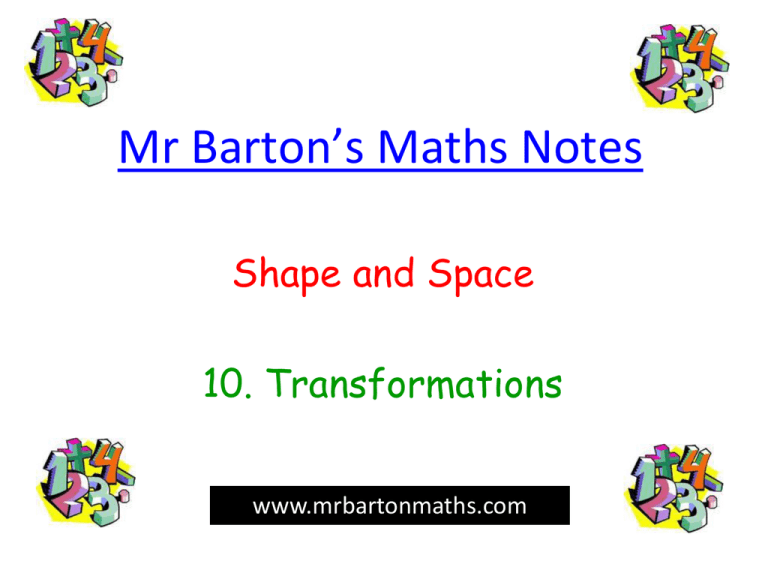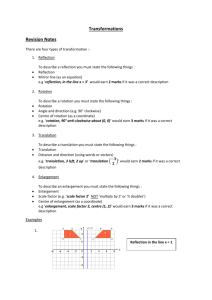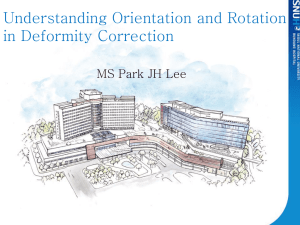This is just a test to see if notes will appear here…
advertisement

Mr Barton’s Maths Notes Shape and Space 10. Transformations www.mrbartonmaths.com 10. Transformations What are Transformations and What do you need to be able to do? • Transformations are specific ways of moving objects, usually around a co-ordinate grid • There are 4 types of transformations you need to be clued up on, and for each one you must - Be able to carry out a transformation yourself - Be able to describe a transformation giving all the required information 1. Translation A Translation is a movement in a straight line, described by a movement right/left, followed by a movement up/down Describing Translations You must give the vector which describes the translation 3 4 If this number is positive, you move right, if it is negative, you move left If this number is positive, you move up, if it is negative, you move down If we translate the blue object by the vector: 8 8 to the right 5 5 up We end up with the green object Notice: If you pick any co-ordinate on the blue shape and translate it by the same vector, you end up with the matching corner on the green shape If we translate the blue object by the vector: 5 5 to the right 5 5 down We end up with the green object 2. Reflection Reflecting an object across a line produces an exact replica (mirror image) of that object on the other side of the line. This new shape is called the Image Describing Reflections You must give either the equation of the line of reflection (mirror line) or draw the line on the grid. If we reflect the blue object in the red line (equation: x = 2), we end up with the purple object Notice: Every point on the purple object (the image) is the exact same distance from the line of reflection as the matching point on the blue object If we reflect the blue object in the red line (equation: y = x), we end up with the purple object Notice: I find it much harder to reflect when the mirror line is diagonal, but notice how every point on the image is still the same distance away from the mirror line as the matching point on the original object. 3. Rotation Rotating an object simply means turning the whole shape around a fixed point by a certain number of degrees and in a certain direction! Remember: If you a like Mr Barton and you can’t do these in your head, then all you need to do is: - trace around the object - place your pencil at the centre of rotation (the fixed point) - turn the tracing paper around - draw your rotated object! Describing Rotations Warning: People always forget to give all the information here and lose loads of easy marks! You must give all of the following: 1. The centre of rotation (give as a co-ordinate if you can) 2. The direction of the rotation (clockwise or anti-clockwise) 3. The angle of the rotation (usually either 900, 1800 or 2700) To describe the rotation from the blue object to the purple object, we would say: 1. Centre of Rotation: (0, 0) – the origin 2. Direction of Rotation: Clockwise 3. Angle of Rotation: 900 Notice: If you wanted to be clever, you could also say it was an anti-clockwise 2700 rotation! To describe the rotation from the blue object to the purple object, we would say: 1. Centre of Rotation: (2, 1) 2. Direction of Rotation: Clockwise 3. Angle of Rotation: 1800 Notice: Whenever the angle of rotation is 1800, it doesn’t matter whether you go clockwise or anti-clockwise! 4. Enlargement Enlargement is the only one of the four transformations which changes the size of the object Key Point: Enlargements can make objects bigger as well as smaller! Each length is increased or decreased by the same scale factor (a) Scale Factor = 3 (b) Scale Factor = 4 And going from big to small… (a) Scale Factor = 1 3 1 (b) Scale Factor = 4 Describing Enlargements To fully describe an enlargement, you must give: 1. The centre of enlargement (give as a co-ordinate if you can) 2. The scale factor of the enlargement To describe the enlargement from the blue object to the purple object, we would say: 1. Centre of Enlargement: (-8, -6) 2. Scale Factor of Enlargement: 2 Notice: (1) To find the centre of enlargement you must draw line through matching points on both objects and see where they cross (2) Each point on the purple object if twice as far away from the centre of enlargement than the matching point on the blue! To describe the enlargement from the blue object to the purple object, we would say: 1. Centre of Enlargement: (-6, 5) 2. Scale Factor of Enlargement: 1 3 Notice: (1) The object has gone smaller, so it must be a fractional scale factor! (2) Each point on the purple object if one-third as far away from the centre of enlargement than the matching point on the blue! Good luck with your revision!











